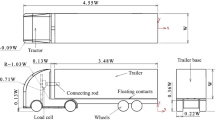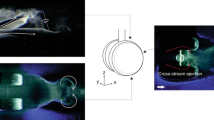Abstract
This paper describes the flow about a smooth isolated wheel rolling steadily along a plane surface. The shape chosen is typical of those used for Formula 1 racing cars, and it is fitted with an inflatable tyre to ensure that an appropriate contact patch geometry is realised. Single-pass PIV is used to obtain instantaneous records of the velocity field around the wheel, and examples of the detailed wake structure are presented. The evolution of the vortices generated by the wheel and shed into the wake is studied for a range of yaw angles up to 6°. It is shown that the structure of the wake for the unyawed wheel fluctuates considerably, switching between distinct states where a dominant lower ground vortex is observed on either the left or the right side of the wake or a third state where a symmetrical pair of vortices forms. Yawing the wheel, even by as little as 2°, which will frequently arise in practical situations due to cross winds or steering the vehicle, biases the flow towards the leeside which inhibits the switching. In such a case, a stable dominant leeside lower ground vortex is formed and the wake structure changes significantly. The origin of the ground vortex formation ahead of the wheel is identified as vorticity coming from the boundary layer generated on the front face of the tyre and not the “jetting phenomenon” as is widely assumed.
Graphical abstract






















Similar content being viewed by others
Notes
The “right-hand” axes convention is used in this paper. The positive direction of yaw as depicted in this figure and, more clearly, in Fig. 18 is consistent with this rule. However, it should be noted that in some of the references cited in this paper, positive yaw is defined in the reverse direction.
References
Stuart TA, Mao X, Gan L (2016) Transient growth associated with secondary vortices in ground/vortex interactions. AIAA J 54(6):1901–1906
Wäschle A (2007) The Influence of rotating wheels on vehicle aerodynamics—numerical and experimental investigations. SAE Technical Paper No. 2007-01-0107
Knowles RD, Saddington AJ, Knowles K (2013) On the near wake of a Formula One front wheel. Proc I MechE Part D: J Automobile Engineering 227(11):1491–1502. https://doi.org/10.1177/0954407013491903
Axerio-Cilies J, Iaccarino G (2012) An aerodynamic investigation of an isolated rotating Formula 1 wheel assembly. J Fluids Eng 134(12):121101. https://doi.org/10.1115/1.4007890
Axerio J, Iaccarino G, Issakhanian E, Lo K, Elkins C, Eaton J (2009) Computational and experimental investigation of the flow structure and vortex dynamics in the wake of a Formula 1 tire, SAE Technical Paper 2009-01-0775. https://doi.org/10.4271/2009-01-0775
Bearman PW (1968) On vortex shedding from a circular cylinder in the critical Reynolds number regime. J Flui Mech 37(3):577–585
Croner E, Bézard H, Sicot C, Mothay G (2013) Aerodynamic characterization of the wake of an isolated rolling wheel. I J of Heat Fluid Flow 43:233–243. https://doi.org/10.1016/j.ijheatfluidflow.2013.04.008
De Gregorio F, Visingardi A (2020) Vortex detection criteria assessment for PIV data in rotorcraft applications. Exp Fluid 61:179. https://doi.org/10.1007/s00348-020-03012-7
Fackrell JE (1974) The aerodynamics of an isolated wheel rotating in contact with the ground. Ph.D. thesis, University of London, London, U.K
Fackrell JE, Harvey JK (1975) The Aerodynamics of an Isolated Road Wheel. Proc Second AIAA Symp Aerodyn Sports Compet Autom 16(1975):4
Gérardina F, Gentric C, Midouxc N (2014) Particle dispersion in the near-wake of an isolated rotating wheel: experimental and CFD study. J Aerosol Sci 76:56–71
Gleason ME, Duncan B, Walter JA, Guzman A, Yong-CC (2015). Comparison of computational simulation of automotive spinning wheel flow field with full width moving belt wind tunnel results. SAE Technical Paper 2015-01-1556. https://doi.org/10.4271/2015-01-1556
Graftieaux L, Michard M, Grosjean N (2001) Combining PIV, POD and vortex identification algorithms for the study of unsteady turbulent swirling flows. Meas Sci Technol 12(9):1422
Harvey JK, Perry FJ (1971) Flowfield produced by trailing vortices in the vicinity of the ground. AIAA J 9(8):1659–1660
Huminic A, Huminic G (2017) Aerodynamic study of a generic car model with wheels and underbody diffuser. Int J Automot Technol 18(3):397–340. https://doi.org/10.1007/s12239-017-0040-6
Hunt JCR, Wray AA, Moin P (1988) Eddies, stream, and convergence zones in turbulent flows. Cent Turbul Res Rep CTR-S88:193–208
Inoue O (1981) MRS criterion for flow separation over moving walls. AIAAJ 19(9):1108–1111
Issakhanian E, Elkins C, Lo K, Eaton J (2010) An experimental study of the flow around a formula one racing car tire. ASME J Fluids Eng 132:071103
Kothalawala TD, Gatto A, Wrobel L (2013) Computational investigation of the combined effects of yaw, rotation & ground proximity on the aerodynamics of an isolated wheel. Int J Mech Aerosp Indus Mechatr Manuf Eng 7(9)
Landström C, Josefsson L, Walker T, Löfdahl L (2011a) An experimental investigation of wheel design parameters with respect to aerodynamic drag. In: 9th FKFS conference, progress in vehicle aerodynamics and thermal management, Stuttgart
Landström C, Walker T, Christoffersen L, Löfdahl L (2011b) Influences of different front and rear wheel designs on aerodynamic drag of a sedan type passenger car, SAE Technical Paper 2011-01-0165. https://doi.org/10.4271/2011-01-0165
Lawson NJ, Wu J (1997) Three-dimensional particle image velocimetry: error analysis of stereoscopic techniques. Meas Sci Technol 9(9):894–900
Lombard J-EW (2017) A high-fidelity spectral/hp element LES study of Formula 1 front-wing and exposed wheel aerodynamics. Imperial College PhD
McManus J, Zhang X (2006) A computational study of the flow around an isolated wheel in contact with the ground. J Fluids Eng Trans ASME 128(3):520–530
Mears AP (2004) The aerodynamic characteristics of an exposed racing car wheel. PhD Thesis, University of Durham
Mears AP, Dominy RG (2004) Racing car wheel aerodynamics—comparisons between experimental and CFD derived flow-field data. Technical Paper 2004-01-3555, Society of Automotive Engineers, Warrendale, PA
Mears AP, Dominy RG, Sims-Williams DB (2004) The flow about an isolated rotating wheel – effects of yaw on lift, drag and flow structure.In: 4th MIRA international conference on vehicle aerodynamics, Warwick, UK, 16–17 October 2002. Nuneation, Warwickshire: MIRA
Mercker E, Breuer N, Berneburg H, Emmelmann HJ (1999) On the aerodynamic interference due to rolling wheels of passenger cars. SAE Technical Paper 910311. https://doi.org/10.4271/910311
Morgan C (2010) Unsteady vortex interactions related to a formula one car front wing and wheel. PhD Thesis, University of Cambridge
Nigbur JE (1999) Characteristics of the wake downstream of an isolated automotive wheel. MSc Thesis, Cranfield University, Bedfordshire, UK
Parfett A (2020) Flow around cambered and yawed pneumatic tyres. PhD Thesis, University of Cambridge
Peace AJ, Riley N (1983) A viscous vortex pair in ground effect. J Fluid Mech 129:409
Pirozzoli S, Orlandi P, Bernardini M, Bernardini M (2012) The fluid dynamics of rolling wheels at low Reynolds number. J Flui Mech 706:496–533. https://doi.org/10.1017/jfm.2012.273
Raffel M, Willert CE, Wereley ST, Kompenhans J (2007) Three-component piv measurements. Particle image velocimetry: a practical guide, 2nd edn, Springer, New York, pp 209–239
Saddington AJ, Knowles RD, Knowles K (2007) Laser doppler anemometry measurements in the near-wake of an isolated formula one wheel, Springer-Verlag. Exp Fluids 42(5):671–681
Schnepf B, Schütz T, Indinger T (2015) Further investigations on the flow around a rotating, isolated wheel and detailed tread pattern. SAE Technical Paper 2015-01-1554. https://doi.org/10.4271/2015-01-1554
Simpson CE, Babinsky H, Harvey JK, Corkery S (2018) Detecting vortices within unsteady flows when using single-shot PIV. Exp Fluids 59(8):125
Sprot AJ (2013) Open-wheel aerodynamics: effects of tyre deformation and internal flow. PhD Thesis, Durham University. Available at Durham E-Theses Online: http://etheses.dur.ac.uk/7292/
Acknowledgements
The assistance provided by Mercedes-AMG Petronas Formula 1 team and the British Engineering and Physical Sciences Research Council in funding this work is gratefully acknowledged.
Funding
Engineering and Physical Sciences Research Council, Mercedes-AMG Petronas Formula 1 Team.
Author information
Authors and Affiliations
Corresponding author
Additional information
Publisher's Note
Springer Nature remains neutral with regard to jurisdictional claims in published maps and institutional affiliations.
Appendices
Appendix 1: The Γ2 variable
Within a flow, Γ2 indicates the degree of rotation about a point P by considering all the velocity vectors in a region S surrounding P containing N grid points after first subtracting the average drift velocity UP within the region. Γ2 was devised by Graftieaux et al. (2001) and is a non-local variable that does not involve differentiation. As such it is generally better at identifying vortices from an array of velocity vectors than the vorticity which is susceptible to noise within the data. It is directly based on the velocity field topology without using velocity derivatives. A visual interpretation of the function is depicted in Fig.
22.
Γ2 is the mean of the sine of the angles between the radial vector PM and the flow velocity vectors after the removal of the average drift velocity UP. As such it can vary between − 1 and 1, with 1 representing all vectors laying at 90° to the radial vector and − 1 representing 270°. Zero indicates that there is no swirl in this plane.
Simpson et al. (2018) discusses the effectiveness of applying the Γ2 method to PIV measurements and demonstrated its effectiveness in analysing single-shot data. For the present data, an interrogation window 11 by 11 data points (that is 0.09 D square) has been selected giving the best balance between in-plane averaging and resolution, taking into account the scale of typical vortices observed in these tests. Contours of |Γ2 | > 0.3 only are shown since any structure below this value are unlikely to be part of any coherent vortices.
There are several alternative ways to identify vortical feature (De Gregorio and Visingardi 2020), a popular one being the method based on Q proposed by Hunt et al. (1988) which is the residual of the vorticity tensor norm squared subtracted from the strain-rate tensor norm squared,
where S and Ω are the symmetrical and asymmetrical parts of the velocity gradient tensor. This method can lead to ambiguities as strictly it also requires knowledge that the pressure is below the ambient value to ensure that it detects vortices unambiguously. Alternative to the Γ2 criterion have not proved as effective in this study.
Simpson et al. (2018) showed that |Γ2| values above 0.6 were capable of unambiguously detecting a simulated Lamb Oseen vortex when significant random noise was added to the vectors with a standard deviation of 30% of peak velocity. This noise rejection property of the Gamma Criterion is of great value when analysing PIV data, particularly that from single-pass tests which are inevitably more prone to noise than results from averaged multiple runs.
Appendix 2: Streamline segments
Short streamline segments that indicate the local crossflow direction are constructed as an aid in interpreting the Γ2 contour plots. Figure
23 illustrates this construction for a y – z plane located at a streamwise location xΓ2. A streamwise interrogation length dx is selected together with a grid of points in a y – z plane at \(x={x}_{\gamma }-0.5{d}_{x}\) from which the streamline to be constructed originate. The velocity at each grid point is evaluated by interpolation from the measured PIV data. The streamline segments are then constructed incrementally from the starting point for a short distance δ, at which point the velocities are re-evaluated by interpolation and the process repeated until \(x\; = \;x_{\gamma } + 0.5d_{x} .\) It should be noted that these are not true instantaneous streamlines; the model wheel moves past a stationary laser plane and thus data for incremental values of x are captured at slightly increasing values of time.
Rights and permissions
About this article
Cite this article
Parfett, A., Babinsky, H. & Harvey, J.K. A study of the time-resolved structure of the vortices shed into the wake of an isolated F1 car wheel. Exp Fluids 63, 116 (2022). https://doi.org/10.1007/s00348-022-03458-x
Received:
Revised:
Accepted:
Published:
DOI: https://doi.org/10.1007/s00348-022-03458-x






